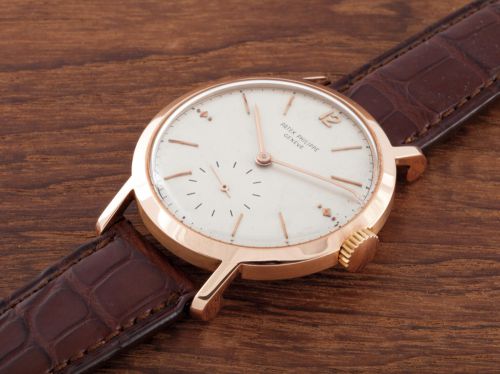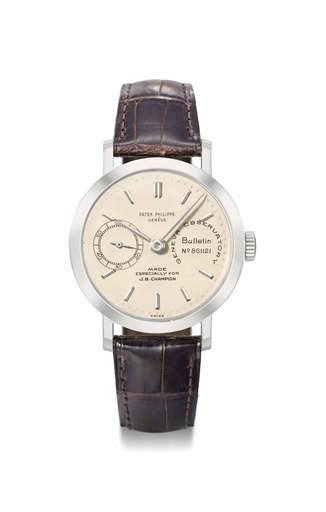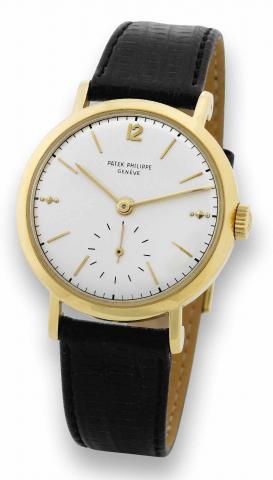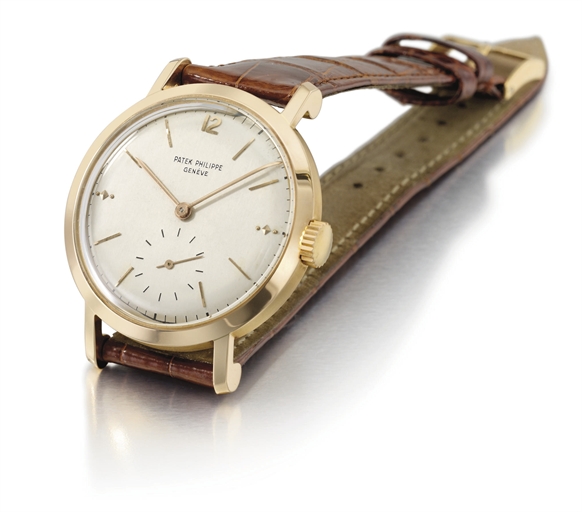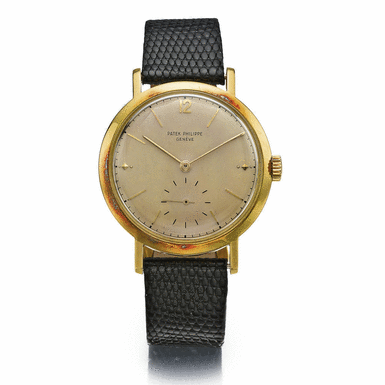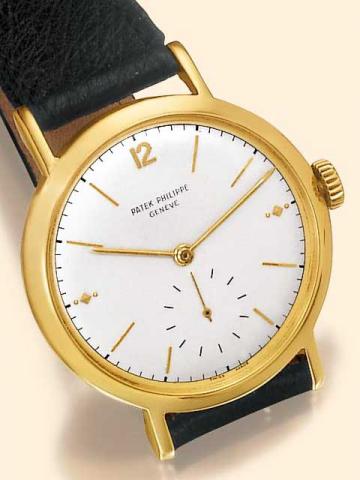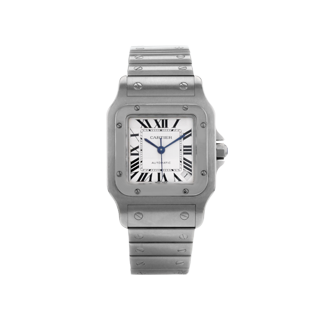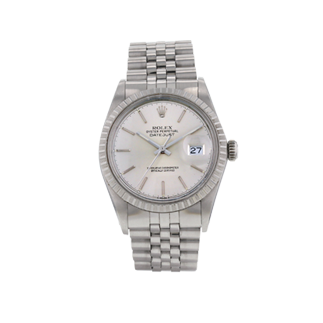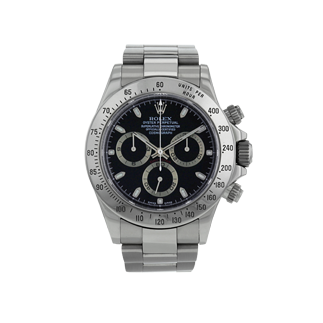L'index des Montres Patek Philippe Calatrava 2458
La cote des montres Patek Philippe Calatrava 2458 d'occasion
Prix des montres Patek Philippe Calatrava 2458 d'occasion
A découvrir sur Collector Square
A découvrir sur Collector Square
Voir la cote d'une référence de Patek Philippe Calatrava
Rechercher une référence
Vous disposez d'une montre Patek Philippe à vendre ?
Nous vous invitons à remplir notre formulaire de demande d'expertise.
Détails (10 résultats)
-
![Patek Philippe. An 18K gold manual wind wristwatch retailed by Trucchi]() Date de vente : 22/05/2024Pays : Royaume-Uni
Date de vente : 22/05/2024Pays : Royaume-Uni
Bonhams #29151 - 2024-05 - Watches/WristwatchesLondonID Lot : 69- GBP
- EUR
- USD
Vendu:- 9984
- 11674
- 10855
Catégorie : Montre braceletPériode : 1950'sID Montre : 723784Mouvement : MécaniqueCalibre : 12 400 TMatière boîtier : Or jauneForme du boitier : RondDétail référence : 2458Fermoir : Boucle déployante
Patek Philippe. An 18K gold manual wind wristwatch retailed by Trucchi
Description : Model: Calatrava Reference: 2458 Date: Circa 1950 Movement: Jewelled Cal.12-400 manual wind, No.723784 Dial: Silvered, applied gilt baton hour markers with Arabic numeral 12 and pyramid quarters, subsidiary seconds at 6, gilt pointed baton hands Case: Polished round, snap on back, No.682583 Strap/Bracelet: Associated black leather Buckle/Clasp: Associated steel buckle Signed: Case, dial & movement Size: 37mmVoir la description de notre expertPatek Philippe. An 18K gold manual wind wristwatch retailed by Trucchi
-
![161.Patek Philippe]() Date de vente : 10/05/2015Pays : Suisse
Date de vente : 10/05/2015Pays : Suisse
Phillips #CH080215 - 2015-05 - The Geneva Watch Auction: OneGenevaID Lot : 161- CHF
- EUR
- USD
Vendu:- 13750
- 11219
- 15720
Estimation:- 10000 - 15000
- 8159 - 12239
- 11433 - 17150
Catégorie : Montre braceletMouvement : MécaniqueCalibre : TMatière boîtier : Or roseForme du boitier : RondCouleur cadran : Blanc
161.Patek Philippe
Description : 2458, 18k pink gold.1951.36mm. Diameter.Calibre: Manual, 12'''120.Case, dial and movement signedVoir la description de notre expert161.Patek Philippe
-
![Patek Philippe. An exceptional, highly attractive, historically important and certainly unique platinum chromometer wristwatch with Guillaume balance, Bulletin d'Observatoire, additional diamond-set dial and platinum bracelet]() Date de vente : 12/11/2012Pays : Suisse
Date de vente : 12/11/2012Pays : Suisse
Christies #1391 - 2012-11 - Important watchesGenevaID Lot : 88- CHF
- EUR
- USD
Vendu:- 3779000
- 4320531
- 3083286
Estimation:- 2000000 - 4000000
- 1631800 - 3263600
- 2286600 - 4573200
Catégorie : Montre braceletPériode : 18ème siècleID Montre : 861121Mouvement : MécaniqueCalibre : 13Matière boîtier : PlatinumForme du boitier : RondAvec diamand : Oui :Détail référence : 2458Complications : Astronomique, Chronomètre
Patek Philippe. An exceptional, highly attractive, historically important and certainly unique platinum chromometer wristwatch with Guillaume balance, Bulletin d'Observatoire, additional diamond-set dial and platinum bracelet
Description : Lot Description.Patek Philippe. An exceptional, highly attractive, historically important and certainly unique platinum chromometer wristwatch with Guillaume balance, Bulletin d'Observatoire, additional diamond-set dial and platinum bracelet.Signed Patek Philippe, Genève, Geneva Observatory Bulletin no. 861121, made especially for J.B Champion, ref. 2458, movement no. 861'121, case no. 673'916, manufactured in 1952.Cal. 13''' Lépine, mechanical movement numbered twice and stamped twice with the Geneva seal, three-quarter plate, 20 jewels, blued steel Breguet balance spring, Guillaume balance, micrometer regulator, silvered matte dial, applied baton numerals, outer beady minute divisions, gold feuille hands, subsidiary seconds, circular heavy case, snap on back, platinum Patek Philippe buckle, case, dial and movement signed.36 mm. diam.__________________________Guillaume__________________________ J.B Champion_____ 2458_1952__ PATEK PHILIPPE. AN EXCEPTIONAL, HIGHLY ATTRACTIVE, HISTORICALLY IMPORTANT AND CERTAINLY UNIQUE PLATINUM CHRONOMETER WRISTWATCH WITH GUILLAUME BALANCE, BULLETIN D’OBSERVATOIRE, ADDITIONAL DIAMOND-SET DIAL AND PLATINUM BRACELET SIGNED PATEK PHILIPPE, GENEVE, GENEVA OBSERVATORY BULLETIN NO. 861121, MADE ESPECIALLY FOR J.B CHAMPION, REF. 2458, MOVEMENT NO. 861’121, CASE NO. 673’916, MANUFACTURED IN 1952 Cal. 13’’’ Lépine, mechanical movement numbered twice and stamped twice with the Geneva seal, three-quarter plate, 20 jewels, blued steel Breguet balance spring, Guillaume balance, micrometer regulator, silvered matte dial, applied baton numerals, outer beady minute divisions, gold feuille hands, subsidiary seconds, circular heavy case, snap on back, platinum Patek Philippe buckle, case, dial and movement signed 36 mm. diam _______________________.Special Notice.Prospective purchasers are advised that several countries prohibit the importation of property containing materials from endangered species, including but not limited to coral, ivory and tortoiseshell. Accordingly, prospective purchasers should familiarize themselves with relevant customs regulations prior to bidding if they intend to import this lot into another country..Pre-Lot Text.Determining the longitudes, chronometry and observatory trials, a brief historical introduction.We thank Arnaud Tellier, horological expert, former director and curator of the Patek Philippe Museum, Geneva..With the invention of the pendulum in the late 1650s, then of the balance spring in 1675, horology could claim the status of an exact science. This considerable progress is due to Christiaan Huygens (1629-1695), Dutch mathematician, astronomer and physicist..In the early eighteenth century, the improvement of the adjusting of timepieces became obvious, nevertheless, it was also true that the search for absolute accuracy was just at its beginning..The precision of clocks and watches is essential since, once embarked on a ship, they can be used to determine the longitude, that is, to finds one's position in the middle of the ocean. The maritime nations of the time - England, Spain, France and the Netherlands - were dismayed by the disasters caused by errors in longitude. For example, the loss of the squadron under the command of Sir Cloudesley Shovell (1650-1707), which shipwrecked on the Isles of Scilly (or Sorlingues) while believing they were in the English Channel (1707), had such a strong impact that years later the British Parliament organized a contest for any method of defining the longitude at sea, offering as incentive 10'000 for a result not exceeding 1 degree of error, 15'000 for 40 minutes and 20'000 for 1/2 degree or less. This was the famous contest of Queen Anne in 1714..In London, the work of Henri Sully (1680-1729), George Graham (1673-1751) and John Harrison (1693-1776) marked the beginning of the eighteenth century. It was in 1735 that Harrison won the contest with his H1 chronometer, but only in 1751 was he able to obtain the first part of the award presented upon the construction of a fourth version. Later on, in 1773, the support offered by King George III (1738-1820) helped him receive the second half of the award for his fifth chronometer. It should also be noted that in 1757, in London, Thomas Mudge (1715-1794) developed the first watch equipped with a lever escapement which since then has been universally used in horology..In France, the watchmakers were equally concerned with the longitude issue. In 1766, Pierre Le Roy (1717-1785) presented in Paris his first chronometer. He built it on entirely new principles that were preserved as the basis of the modern chronometry (detent escapement, isochronous spring, self-compensating balance equipped with adjustable compensation weights, temperature compensation with mercury). He also presented a bi-metallic compensation balance and established the Pierre Le Roy rule stating that for each spring there is a length that makes it isochronous. In 1768, his great rival, Ferdinand Berthoud (1727-1807), completed the first of his marine pieces and also invented a compensation balance. In 1770, Pierre Le Roy was awarded the two prizes offered successively by the Royal Academy of Sciences for the best way of measuring time at sea..In 1772, John Arnold (1736-1799) built in London his first bi-metallic compensation balance based on the principles established by Pierre Le Roy, later on, in 1790, he improved the spring detent escapement. Another British watchmaker, Thomas Earnshaw (1749-1829), developed a marine chronometer so advanced and perfected that its basic principle remained unchanged until the advent of quartz clocks. The rivalry between the two watchmakers was as strong as the one between Le Roy and Berthoud..Chronometry developed in England of the eighteenth century to the point of becoming an industry, while in France it also grew to be an important manufacture under the guidance of Pierre-Louis Berthoud (1754-1813), Ferdinand Berthoud's nephew and disciple, who invented his own pivoted detent escapement..The siècle des Lumières is the time when the marine chronometers were tested in long and perilous journeys. The nineteenth century was when the tests in the astronomical observatories helped verify scientifically several chronometers at once..As early as 1766, the Greenwich Royal Observatory, near London, organized sporadically the first precision contests. In 1823, the British Admiralty created a contest with 300, 200 and 100 Pounds Sterling in prize money, hoping that this way it will acquire for its fleet the best chronometers. Similarly, and at the same time, the French Royal Navy paid 2400 Francs for the award winning chronometers..In 1790, Geneva witnessed the first precision contest among chronometers held at the Society for the Advancement of the Arts. Later on, in 1816, the Astronomical Observatory of Geneva hosted the creation of a trial, which subsequently was conducted only occasionally. It was not until 1879 that this type of contest became an institution. The precision level of the watches is evaluated through a points system set at that time by Emile Plantamour (1815-1882), Director of the Observatory. This system with prizes (1st, 2nd and 3rd prize, then honorable mention or without) and different classes (marine chronometer, deck or pocket, with or without special features), was shortly after joined in 1884 by the Astronomical Observatory of Kew and Teddington in Great Britain and, in 1885, by that of the Astronomical Observatory of Besançon, in France. The contests organized by the Neuchâtel, Hamburg and Washington observatories also enjoyed greatest consideration. Unfortunately, it hasn't been possible to standardize the tests between the different countries, so today it is impossible to compare their results. In addition to publishing the rankings in the official publications, the award winning time-pieces also received an official certificate of accuracy and a gold, silver or bronze medal..Patek Philippe and the Timing Competitions.Patek Philippe watches participated with remarkable success at many of the trials which soon became very important events, nationally and internationally. In 1884 and 1895, the Geneva manufacturer managed to also win the prestigious series prize for the five most precise pocket watches. Between 1900 and 1939 - the year when the firm celebrated its centennial - it won 764 prizes in Geneva, of which 187 were first prizes, this represents more than half of the prizes awarded during that time..Between 1943 and 1966, Patek Philippe presented 480 times to the Geneva Astronomical Observatory movements (simple, with no complications) from the D category (format not exceeding 30 mm in diameter or 706.86 mm2) and 27 times movements with a tourbillion regulator. As these movements could be presented on several occasions over the years, it would be difficult to determine the exact number of manufactured wristwatch chronometer movements. Moreover, many of them would never be sold and are currently preserved in the vaults of the manufacturer and the company's own museum..Patek Philippe did also compete in contests abroad. This is particularly the case during the 1960s when the manufacturer received the highest British distinction, the Craftsmanship Test, introduced in 1951. Only twelve watches can claim to have won it, amongst them the Patek Philippe pocket watch with tourbillon, No 198'423, having furthermore achieved the best results ever. The Observatory of Geneva tests were interrupted in 1967, with the arrival of quartz watches..The COSC.Today only COSC (Contrôle Officiel Suisse de Chronométrie the Official Swiss Chronometer Testing Institute) performs accuracy testing and issues certificates. A law dated November 6th, 1886 on testing the accuracy of the pocket watches at the Geneva Observatory, set the conditions, certified through an official engraved hallmark, where the Geneva quality is applied to certain watches. This stamp has the same value as an official accuracy certificate and allows qualifying the watch as a chronometer. After several amendments and additions in 1891, 1931 and 1955, made necessary by the technical progress, the regulation on testing of the mechanical watches received its final form on April 5th, 1957..View.Lot Notes ›Voir la description de notre expertPatek Philippe. An exceptional, highly attractive, historically important and certainly unique platinum chromometer wristwatch with Guillaume balance, Bulletin d'Observatoire, additional diamond-set dial and platinum bracelet
-
![PATEK PHILIPPE - A RARE AND LARGE 18K YELLOW GOLD WRISTWATCH 1950 REF 2458 MVT 965930 CASE 657003]() Date de vente : 06/12/2011Pays : États-Unis
Date de vente : 06/12/2011Pays : États-Unis
Sothebys #N08772 - 2011-12 - Important Watches & ClocksNew YorkID Lot : 353- USD
- EUR
- USD
Vendu:- 15625
- 11144
- 15625
Estimation:- 5000 - 7000
- 3566 - 4992
- 5000 - 7000
Catégorie : Montre braceletMatière boîtier : Or jauneDétail référence : 2458
PATEK PHILIPPE - A RARE AND LARGE 18K YELLOW GOLD WRISTWATCH 1950 REF 2458 MVT 965930 CASE 657003
Description : A very nice example. The movement is running at the time of cataloguing, however it may require service soon. The dial.The case is very nicely preserved, with a strong 18K mark to the outside of the back and good definition to the lugs. There are some surface scuffs throughout.Voir la description de notre expertPATEK PHILIPPE - A RARE AND LARGE 18K YELLOW GOLD WRISTWATCH 1950 REF 2458 MVT 965930 CASE 657003
-
![Patek Philippe, Ref. 2458 Yellow Gold.Patek Philippe, Gen]() Date de vente : 09/10/2010Pays : Hong Kong
Date de vente : 09/10/2010Pays : Hong Kong
Antiquorum #241 - 2010-10 - Important Modern & Vintage TimepiecesHong KongID Lot : 282- HKD
- EUR
- USD
Vendu:- 150000
- 13770
- 19305
Estimation:- 80000 - 120000
- 7344 - 11016
- 10296 - 15444
Catégorie : Montre braceletPériode : 1950'sCalibre : 12 120Matière boîtier : Or jauneForme du boitier : RondCouleur cadran : ArgentDétail référence : 2458Epaisseur : 9 mm
Patek Philippe, Ref. 2458 Yellow Gold.Patek Philippe, Gen
Description : C. Two-body, solid, polished and brushed, straight curved.lugs, snap-on case back..D. Matte silver with applied yellow gold baton, pyramid and.round indexes and Arabic 12, subsidiary seconds dial, outer.minute track. Yellow gold baton hands..M. Cal. 12 '''120, rhodium-plated, fausses cotes decoration.18 jewels, straight-line lever escapement, monometallic.balance, self-compensating Breguet balance spring.swan-neck regulator..Dial, case and movement signed..Diam. 36 mm. Thickness 9 mm.Voir la description de notre expertPatek Philippe, Ref. 2458 Yellow Gold.Patek Philippe, Gen
-
![Ref. 2458 Yellow Gold.Patek Philippe & Cie, Gen]() Date de vente : 17/09/2009Pays : États-Unis
Date de vente : 17/09/2009Pays : États-Unis
Antiquorum #219 - 2009-09 - Important Collector's Wristwatches, Pocket Watches & ClocksSession 1New YorkID Lot : 124- USD
- EUR
- USD
Vendu:- 10200
- 7275
- 10200
Estimation:- 7500 - 9500
- 5349 - 6775
- 7500 - 9500
Catégorie : Montre braceletPériode : 1950'sID Montre : 969936Calibre : 12 400Matière boîtier : Or jauneForme du boitier : RondCouleur cadran : ArgentDétail référence : 2458Epaisseur : 9 mm
Ref. 2458 Yellow Gold.Patek Philippe & Cie, Gen
Description : C. Two-body, solid, polished, straight lugs. D. Matte silver with.applied yellow gold baton, pyramid and round indexes and.Arabic 12, subsidiary seconds dial. Yellow gold baton hands..M. Cal. 12 '''-400, rhodium-plated, fausses cotes decoration, 18.jewels, straight-line lever escapement, monometallic balance.adjusted for heat, cold, isochronism and 5 positions, shock.absorber, self-compensating Breguet balance spring, swanneck.micrometer regulator..Dial, case and movement signed..Diam. 36 mm. Thickness 9 mm.Voir la description de notre expertRef. 2458 Yellow Gold.Patek Philippe & Cie, Gen
-
![Patek Philippe. A fine and large 18K pink gold wristwatch with unusual lugs]() Date de vente : 11/05/2009Pays : Suisse
Date de vente : 11/05/2009Pays : Suisse
Christies #1366 - 2009-05 - Important watchesGenevaID Lot : 248- CHF
- EUR
- USD
Vendu:- 21250
- 17338
- 24295
Estimation:- 15000 - 25000
- 12239 - 20398
- 17150 - 28583
Catégorie : Montre braceletPériode : 1950'sID Montre : 664559 MANUFACTURED 1951Calibre : 12120Matière boîtier : Or roseForme du boitier : CarréDétail référence : 2458
Patek Philippe. A fine and large 18K pink gold wristwatch with unusual lugs
Description : Lot Description.Patek Philippe. A fine and large 18K pink gold wristwatch with unusual lugs.Signed Patek Philippe, Geneve, ref. 2458, movement no. 969'359, case no. 664'559, manufactured in 1951.Cal. 12'''120 nickel-finished lever movement, 18 jewels, bimetallic compensation balance, swan-neck regulator, silvered dial, applied gold baton, square-shaped and Arabic numerals, subsidiary seconds, circular case, enlarged bezel, snap on back, 18K gold Patek Philippe buckle, case, dial and movement signed.37 mm. diam..Special Notice.Prospective purchasers are advised that several countries prohibit the importation of property containing materials from endangered species, including but not limited to coral, ivory and tortoiseshell. Accordingly, prospective purchasers should familiarize themselves with relevant customs regulations prior to bidding if they intend to import this lot into another country..View Lot Notes ›Voir la description de notre expertPatek Philippe. A fine and large 18K pink gold wristwatch with unusual lugs
-
![Patek Philippe. A fine, large and rare 18K pink gold wristwatch with unusual lugs]() Date de vente : 17/11/2008Pays : Suisse
Date de vente : 17/11/2008Pays : Suisse
Christies #1357 - 2008-11 - Important watchesGenevaID Lot : 266- CHF
- EUR
- USD
Vendu:- 23750
- 19378
- 27153
Estimation:- 20000 - 30000
- 16318 - 24477
- 22866 - 34299
Catégorie : Montre braceletPériode : 1950'sID Montre : 664559 MANUFACTURED 1951Calibre : 12120Matière boîtier : Or roseForme du boitier : RondDétail référence : 2458
Patek Philippe. A fine, large and rare 18K pink gold wristwatch with unusual lugs
Description : Lot Description.Patek Philippe. A fine, large and rare 18K pink gold wristwatch with unusual lugs.Signed Patek Philippe, Genève, ref. 2458, movement no. 969'359, case no. 664'559, manufactured in 1951.Cal. 12'''120 nickel-finished lever movement, 18 jewels, bimetallic compensation balance, swan-neck regulator, silvered dial, applied gold baton, square-shaped and Arabic numerals, circular case, enlarged bezel, snap on back, 18K gold Patek Philippe buckle, case, dial and movement signed.37 mm. diam.View Lot Notes ›Voir la description de notre expertPatek Philippe. A fine, large and rare 18K pink gold wristwatch with unusual lugs
-
![PATEK PHILIPPE - A RARE LARGE GOLD WRISTWATCH 1951 REF 2458J MVT 969455 CASE 667780]() Date de vente : 23/04/2008Pays : États-Unis
Date de vente : 23/04/2008Pays : États-Unis
Sothebys #N08433 - 2008-04 - Important WatchesNew YorkID Lot : 206- EUR
- EUR
- USD
Non vendu- ...
- ...
- ...
Estimation:- 9000 - 11000
- 6419 - 7845
- 9000 - 11000
Catégorie : Montre braceletMatière boîtier : Or jauneDétail référence : 2458J
PATEK PHILIPPE - A RARE LARGE GOLD WRISTWATCH 1951 REF 2458J MVT 969455 CASE 667780
Voir la description de notre expertPATEK PHILIPPE - A RARE LARGE GOLD WRISTWATCH 1951 REF 2458J MVT 969455 CASE 667780
-
![Patek Philippe & Cie, Gen]() Date de vente : 16/11/2002Pays : Suisse
Date de vente : 16/11/2002Pays : Suisse
Antiquorum #32 - 2002-11 - Thematic Auction in Geneva:The Evolution of Forms in HorologyGenevaID Lot : 571- CHF
- EUR
- USD
Vendu:- 6325
- 5161
- 7231
Estimation:- 11000 - 13000
- 8975 - 10607
- 12576 - 14863
Catégorie : Montre braceletID Montre : 721 355Calibre : 12 400 STAMPED GENEVA QUALITY HALLMARKMatière boîtier : Or jauneCouleur cadran : ArgentDétail référence : 2458 . PRO DUCTION
Patek Philippe & Cie, Gen
Description : C. two-body, solid, polished, straight lugs. D. matte silver with applied yellow gold bâton, pyramidal and baton indexes and Arabic numerals, auxiliary seconds dial. Bâton yellow gold hands. M. Cal. 12 '''-400, stamped with the Geneva Quality Hallmark, rhodium-plated, fausses-côtes decoration, 18 je-wels, straight line lever escapement, monometallic balance ad-justed for heat, cold, isochronism and 5 positions, shock-ab-sorber, micrometer regulator, self-compensating Breguet balance-spring.Dial, case and movement signed.Diam. 36 mm.Voir la description de notre expertPatek Philippe & Cie, Gen
A découvrir sur Collector Square
A découvrir sur Collector Square
Vous souhaitez une estimation ?
Faire une demande d'estimation-
![Cartier]()
Cartier
La 3ème marque horlogère la plus vendue aux enchères
-
![Rolex Datejust]()
Rolex Datejust
Son prix moyen a augmenté de 47% en 10 ans
-
![Rolex Daytona]()
Rolex Daytona
Son prix moyen a été multiplié par 2,4 en 4 ans

